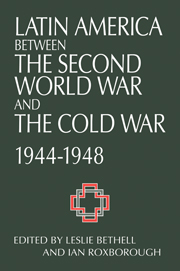Book contents
- Frontmatter
- Contents
- List of contributors
- Preface
- Introduction: The postwar conjuncture in Latin America: democracy, labor, and the Left
- 1 Brazil
- 2 Chile
- 3 Argentina
- 4 Bolivia
- 5 Venezuela
- 6 Peru
- 7 Mexico
- 8 Cuba
- 9 Nicaragua
- 10 Costa Rica
- 11 Guatemala
- Conclusion: The postwar conjuncture in Latin America and its consequences
- Index
Introduction: The postwar conjuncture in Latin America: democracy, labor, and the Left
Published online by Cambridge University Press: 04 May 2010
- Frontmatter
- Contents
- List of contributors
- Preface
- Introduction: The postwar conjuncture in Latin America: democracy, labor, and the Left
- 1 Brazil
- 2 Chile
- 3 Argentina
- 4 Bolivia
- 5 Venezuela
- 6 Peru
- 7 Mexico
- 8 Cuba
- 9 Nicaragua
- 10 Costa Rica
- 11 Guatemala
- Conclusion: The postwar conjuncture in Latin America and its consequences
- Index
Summary
The years between the end of the Second World War and the beginning of the Cold War, that is to say, 1944-5 to 1947-8, constituted a critical conjuncture in the twentieth-century history of Europe (both West and East), the Middle East, India, China, Southeast Asia, and Japan. In contrast, although important political changes occurred in several Latin American countries during these years - the rise of Juan Domingo Peron in Argentina, the election of Juan Jose Arevalo in Guatemala, the end of the Estado Novo in Brazil, the seizure of power by Accion Democratica in Venezuela, the Civil War in Costa Rica, for example - this period has not by and large been regarded as constituting a significant Watershed in the history of the region as a whole, not least because of Latin America's relative international isolation. It is the aim of this volume to establish that although its participation in the Second World War had been only marginal (in military terms at least), and although it was not a focal point of conflict in the Cold War (in the early stages at least), the years 1944-8 nevertheless also represented an important conjuncture in the history of Latin America in the twentieth century.
Each of the twenty Latin American republics has its own history in the years immediately after the Second World War. Nevertheless, despite differences of political regime, different levels of economic and social development, differences in the strength and composition of both dominant groups and popular forces, and different relations with the United States - the region's “hegemonic power” - there are striking similarities in the experience of the majority of the republics.
- Type
- Chapter
- Information
- Latin America between the Second World War and the Cold WarCrisis and Containment, 1944–1948, pp. 1 - 32Publisher: Cambridge University PressPrint publication year: 1993
- 1
- Cited by



